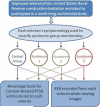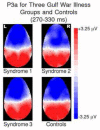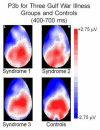Visual event-related potentials as markers of hyperarousal in Gulf War illness: evidence against a stress-related etiology
- PMID: 23149040
- PMCID: PMC3578115
- DOI: 10.1016/j.pscychresns.2012.08.004
Visual event-related potentials as markers of hyperarousal in Gulf War illness: evidence against a stress-related etiology
Abstract
An exaggerated response to emotional stimuli is among the many symptoms widely reported by veterans of the 1991 Persian Gulf War. These symptomologies have been attributed to damage and dysfunction associated with deployment-related exposures. We collected event-related potential data from 22 veterans meeting Haley criteria for Gulf War (GW) Syndromes 1-3 and from 8 matched GW veteran controls, who were deployed but not symptomatic, while they performed a visual three-condition oddball task where images authenticated to be associated with the 1991 Persian Gulf War were the distractor stimuli. Hyperarousal reported by ill veterans was significantly greater than that by control veterans, but this was not paralleled by higher amplitude P3a in their ERP responses to GW-related distractor stimuli. Whereas previous studies of PTSD patients have shown higher amplitude P3b responses to target stimuli that are placed amid trauma-related nontarget stimuli, ill veterans in this study showed P3b amplitudes to target stimuli - placed amid GW-related nontarget stimuli - that were significantly lower than those of the control group. Hyperarousal scores reliably predicted P3b, but not P3a, amplitudes. Although many factors may contribute to P3b amplitude differences - most notably depression and poor sleep quality, symptoms that are prevalent in the GW syndrome groups - our findings in context of previous studies on this population are consistent with the contention that dysfunction in cholinergic and dopaminergic neurotransmitter systems, and in white matter and basal ganglia may be contributing to impairments in GW veterans.
Copyright © 2012 Elsevier Ireland Ltd. All rights reserved.
Figures







References
-
- Abdel-Rahman A, Dechkovskaia AM, Goldstein LB, Bullman SH, Khan W, El-Masry EM, Abou-Donia MB. Neurological deficits induced by malathion, DEET, and permethrin, alone or in combination in adult rats. Journal of Toxicology and Environmental Health Part A. 2004;67(4):331–356. - PubMed
-
- Abou-Donia MB, Wilmarth KR, Jensen KF, Oehme FW, Kurt TL. Neurotoxicity resulting from coexposure to pyridostigmine bromide, DEET, and permethrin: Implications of Gulf War chemical exposures. Journal of Toxicology and Environmental Health. 1996;48(1):35–56. - PubMed
-
- Adamec R, Head D, Soreq H, Blundell J. The role of the read through variant of acetylcholinesterase in anxiogenic effects of predator stress in mice. Behavioural Brain Research. 2008;189:180–190. doi:10.1016/j.bbr.2007.12.023. - PubMed
-
- Allman JM, Hakeem A, Erwin JM, Nimchinsky E, Hof P. The anterior cingulate cortex: The evolution of an interface between emotion and cognition. Annals of the New York Academy of Sciences. 2001;935:107–117. - PubMed
-
- Aloisi AM, Casamenti F, Scali C, Pepeu G, Carli G. Effects of novelty, pain and stress on hippocampal extracellular acetylcholine levels in male rats. Brain Research. 1997;748:219–226. - PubMed
Publication types
MeSH terms
Grants and funding
LinkOut - more resources
Full Text Sources
Other Literature Sources

